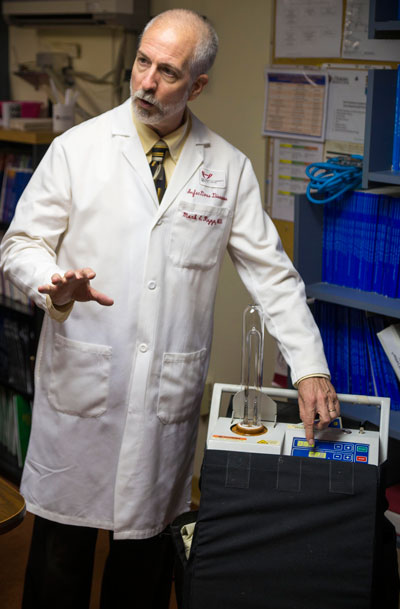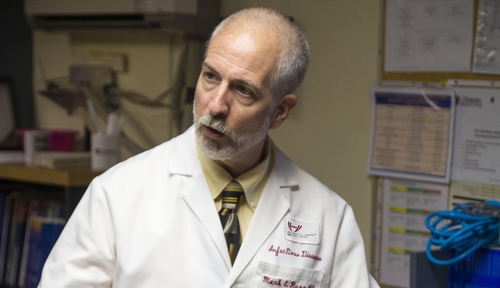 |
Mark Rupp, M.D., discusses the mobile ultraviolet disinfecting robotic device. |
It’s no secret that the problem of hospital-acquired infections is a growing concern in the health care community. It’s also one that Mark Rupp, M.D., is constantly looking to address.
“In the United States, about 5 percent of patients develop infections while they’re in the hospital,” said Dr. Rupp, a professor in the college of medicine and the medical director of The Nebraska Medical Center’s department of infection control. “This equates to somewhere in the neighborhood of 1.5 to 2 million infections per year and an estimated 100,000 deaths.”
What might be a better-kept secret is the new way hospitals are trying to reduce these numbers.
“Manufacturers have recognized that this is a problem,” Dr. Rupp said. “They’ve started to turn technology in this direction.”
The technology used by The Nebraska Medical Center comes in the form of a mobile, ultraviolet disinfecting robotic device that fights germs with pulsed rays of UV light.
“This is reserved for the most dangerous and exotic pathogens,” Dr. Rupp said.
The device is used in rooms where superbugs — bacteria that are especially resistant to antibiotics — have been known to exist.
“We’re identifying those rooms where the person has been infected with particularly resistant or problematic pathogens.”
Because ultraviolet light is harmful to humans, the robot has to be operated by remote control. It’s rolled into the room after a patient has left the hospital and programmed according to the size of the room. Once activated, a long, narrow light bulb emerges from the top of the machine and emits strobe-like pulses. If there are windows in the room, curtains must be drawn.
As effective as it is at killing bacteria, there are some downsides.
“The machines can be a little disruptive, and they generate a bright light,” Dr. Rupp said. “It’s important that the door is closed, and you can’t be present in the room while this machine is running.”
The UV robot isn’t a substitute for a traditional, thorough cleaning.
“They don’t take away from the need to actually clean the environment,” Dr. Rupp said. “These methodologies don’t work very well if you have dirt or debris left behind after the patient is discharged.”
While it’s still hard to beat things like bleach for their antibacterial capacity, Dr. Rupp thinks more high-tech options like the UV robot are on the horizon.
“I see a lot of developments coming along that will help us provide a cleaner, safer environment for the care of patients.”
